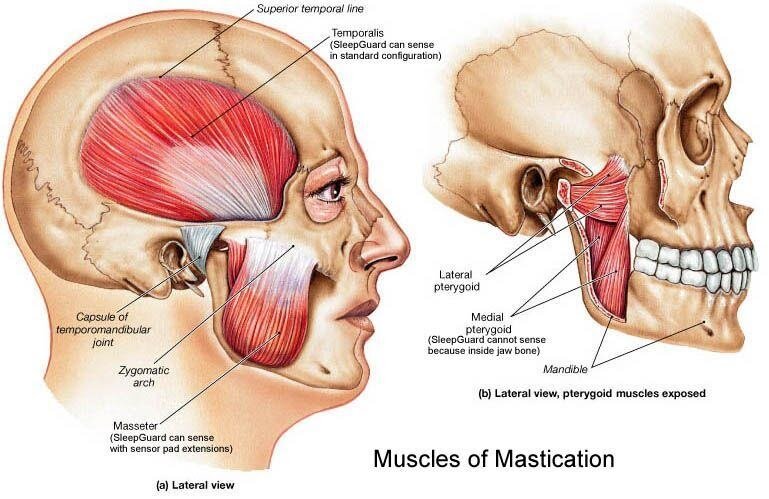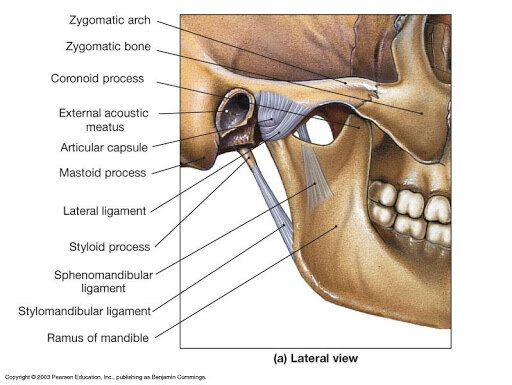The temporomandibular joint (TMJ), pain, and how to fix it.
The Temporomandibular joint (TMJ) is more commonly known as our jaw. The TMJ is the point where the mandible (jaw bone) joins the skull; you can feel this joint directly when you place your fingers posterior to your cheek and anterior to your ear when your jaw is moving up and down, chewing. The TMJ is the articulation of the mandible with the mandibular fossa of the temporal bone in the skull.
The Temporomandibular joint is like any other joint in the body. It is the point where two bones articulate to create movement. The joint is held together passively by ligaments and moved by the contraction of multiple little muscles. It even has its own shock absorber disk similar to the meniscus in the knee!
It has two main supporting ligaments; the lateral ligament and the sphenomandibular ligament. The lateral ligament is responsible for keeping the lower jaw strong by preventing the posterior displacement of the mandible. The sphenomandibular ligament extends from the sphenoid bone of the skull to the ramus of the mandible. The sphenomandibular ligament is on the medial side (closer to the midline) of the temporomandibular joint.
Ligaments play an integral role in supporting the temporomandibular joint; however, the muscles of mastication (chewing) are essential as well and are often the site of dysfunction. Many muscles influence the TMJ because the movement of the jaw is not simply opening and closing. In fact, to open our jaw, it requires two consecutive motions. First, the mandible (your jawbone) must hinge in the groove, which it sits in on the skull (picture a ball in socket joint.) This movement creates more space for the jaw to move. This movement is then followed by a slight forward gliding motion, which allows for the depression of the mandible and opens the jaw. The multiple steps involved in opening our jaw and the complexity of the movement are part of the reason temporomandibular dysfunction is so common. If any of the muscles acting on the jaw are out of sync, the jaw will not move smoothly. This can lead to dysfunction and inflammation, ultimately progressing to pain.
Many muscles are acting on this joint. Some of the muscles involved in moving the jaw are the masseter, the medial and lateral pterygoid, digastric muscle, sternohyoid, geniohyoid, mylohyoid, buccinator, and the temporalis. Many of these are tiny facial muscles most people would have never heard of. With so many components acting on one joint, there is plenty of room for things to go wrong.
The synovial cavity of the TMJ is separated into the superior and inferior chambers by an articular disk. The articular disk allows for a lateral and medial excursion (side to side movement) of the mandible. The disk can be compared to the meniscus in our knee. It acts as a shock absorber between articulating bones.
As previously discussed, the temporomandibular joint has multiple movements and consists of three different types of joints. The TMJ consist of six movements; elevation, depression, protraction, retraction, lateral excursion, and medial excursion. During chewing, the jaw is protracting (moving forward) and retracting (moving backward). When opening the mouth, our mandible depresses, and our mandible elevates when closing our mouth. The side to side movement of the mandible when grinding food between the molars is performed by lateral and medial excursions. The lateral excursion is the movement to the left and right of the zero position of the jaw. The medial excursion is the movement back to the zero position of the jaw (Saladin, pg. 291).
We can experience jaw pain from many different sources. Some of the more traumatic forms of a jaw injury can occur with a deep yawn or a strenuous depression of the jaw. In extreme cases, this can cause dislocation of the condyle and is a serious injury. The joint can be relocated by pressing down on your lower posterior molars while pushing the jaw posteriorly (Saladin, pg. 295).
More commonly than dislocation, however, many people may experience insidious jaw pain periodically throughout the day. It may also be followed by a clicking sound in their jaw when opening wide. This can occur with a displacement of the disk, or it can be a sign of a muscular imbalance. If there is an imbalance between the muscle tone and activation from one side to another, the joints will not move smoothly and result in clicking of the joint. This can be brought on by teeth grinding, excessive chewing (think gum), or chewing of harder food.
There are many different treatment options for a person who is suffering from TMD. For temporary relief of the pain associated with TMJ, people can try to treat the pain and discomfort by eating soft foods, applying ice to the area, trying to avoid eating hard or tough foods that may aggravate their joints in their jaw. To be mindful of when they are yawning. However, there is Gentle jaw stretching and relaxation techniques they can practice that would help alleviate the pain and increase the movement of their jaw.
When altering your diet and avoiding chewing harder items is no longer effective, treatment to the TMJ may be required. As chiropractors, there are multiple ways that we can influence your jaw biomechanics and help with your pain.
Soft tissue muscle release techniques can be extremely effective in treating TMD. As described above, often the pain and dysfunction is a result of a muscular imbalance. After adequately identifying which muscles are influencing the aberrant motion, we can help release some of the offending muscles. You may find that some of the muscles are extremely tender and very tight. These are signs that the muscles may require treatment.
Spinal adjustments to the upper cervical spine (upper neck) may also influence the TMJ’s function and have been shown to help manage temporomandibular dysfunction and treat the musculature.
Other tools available to help manage the pain include working through the root cause of the jaw pain. Many people are entirely unaware, but the main cause of their TMD is not from chewing food but instead grinding their teeth in their sleep. It is very common to grind your teeth without any knowledge while you sleep, and this can put significant stress on the muscles, ligaments, and the joint of your jaw. Your dentist may be able to identify this by evaluating your teeth for any signs of grinding. You may be prescribed a mouth guard to wear at night, which can reduce the wear and tear if you do grind your teeth while you sleep.
The TMJ is a very complex joint that can become very painful. Many people are unaware of the conservative treatment options that are available. A well-trained chiropractor and dentist working together can profoundly impact mitigating and improving the pain in your jaw.
REFERENCES
Saladin, K. S. (2012). Anatomy & physiology: the unity of form and function (7th ed.). New York: McGraw-Hill.
Pearson Education, HealthDent.com/tmj
https://www.nidcr.nih.gov/oralhealth/topics/tmj/tmjdisorders.htm
As previously discussed, the temporomandibular joint has multiple movements and consists of three different types of joints. The TMJ consist of six movements; elevation, depression, protraction, retraction, lateral excursion, and medial excursion. During chewing, the jaw is protracting (moving forward) and retracting (moving backward). When opening the mouth, our mandible depresses, and our mandible elevates when closing our mouth. The side to side movement of the mandible when grinding food between the molars is performed by lateral and medial excursions. The lateral excursion is the movement to the left and right of the zero position of the jaw. The medial excursion is the movement back to the zero position of the jaw (Saladin, pg. 291).
We can experience jaw pain from many different sources. Some of the more traumatic forms of a jaw injury can occur with a deep yawn or a strenuous depression of the jaw. In extreme cases, this can cause dislocation of the condyle and is a serious injury. The joint can be relocated by pressing down on your lower posterior molars while pushing the jaw posteriorly (Saladin, pg. 295).
More commonly than dislocation, however, many people may experience insidious jaw pain periodically throughout the day. It may also be followed by a clicking sound in their jaw when opening wide. This can occur with a displacement of the disk, or it can be a sign of a muscular imbalance. If there is an imbalance between the muscle tone and activation from one side to another, the joints will not move smoothly and result in clicking of the joint. This can be brought on by teeth grinding, excessive chewing (think gum), or chewing of harder food.
There are many different treatment options for a person who is suffering from TMD. For temporary relief of the pain associated with TMJ, people can try to treat the pain and discomfort by eating soft foods, applying ice to the area, trying to avoid eating hard or tough foods that may aggravate their joints in their jaw. To be mindful of when they are yawning. However, there is Gentle jaw stretching and relaxation techniques they can practice that would help alleviate the pain and increase the movement of their jaw.
When altering your diet and avoiding chewing harder items is no longer effective, treatment to the TMJ may be required. As chiropractors, there are multiple ways that we can influence your jaw biomechanics and help with your pain.
Soft tissue muscle release techniques can be extremely effective in treating TMD. As described above, often the pain and dysfunction is a result of a muscular imbalance. After adequately identifying which muscles are influencing the aberrant motion, we can help release some of the offending muscles. You may find that some of the muscles are extremely tender and very tight. These are signs that the muscles may require treatment.
Spinal adjustments to the upper cervical spine (upper neck) may also influence the TMJ’s function and have been shown to help manage temporomandibular dysfunction and treat the musculature.
Other tools available to help manage the pain include working through the root cause of the jaw pain. Many people are entirely unaware, but the main cause of their TMD is not from chewing food but instead grinding their teeth in their sleep. It is very common to grind your teeth without any knowledge while you sleep, and this can put significant stress on the muscles, ligaments, and the joint of your jaw. Your dentist may be able to identify this by evaluating your teeth for any signs of grinding. You may be prescribed a mouth guard to wear at night, which can reduce the wear and tear if you do grind your teeth while you sleep.
The TMJ is a very complex joint that can become very painful. Many people are unaware of the conservative treatment options that are available. A well-trained chiropractor and dentist working together can profoundly impact mitigating and improving the pain in your jaw.
REFERENCES
Saladin, K. S. (2012). Anatomy & physiology: the unity of form and function (7th ed.). New York: McGraw-Hill.
Pearson Education, HealthDent.com/tmj
https://www.nidcr.nih.gov/oralhealth/topics/tmj/tmjdisorders.htm

